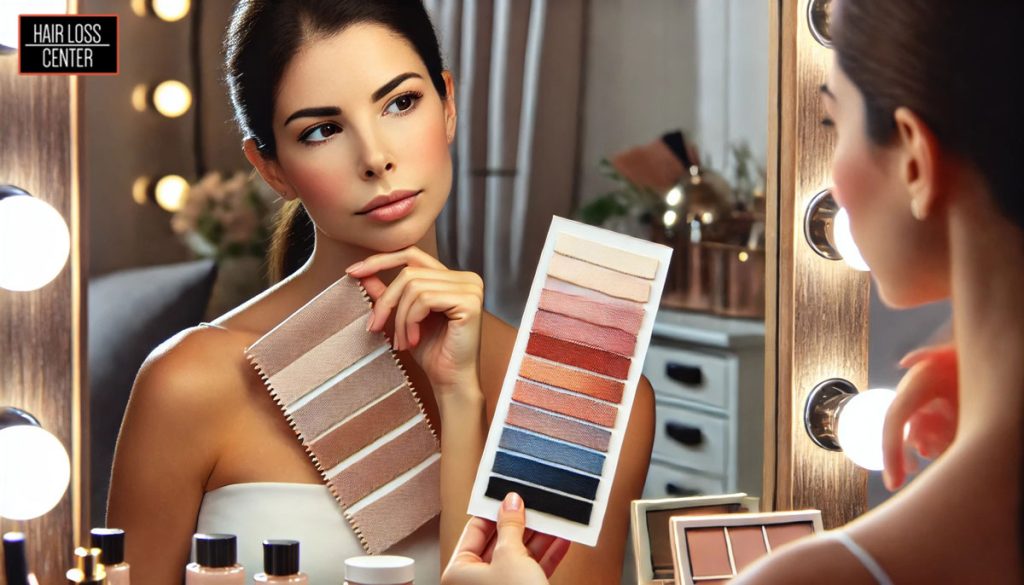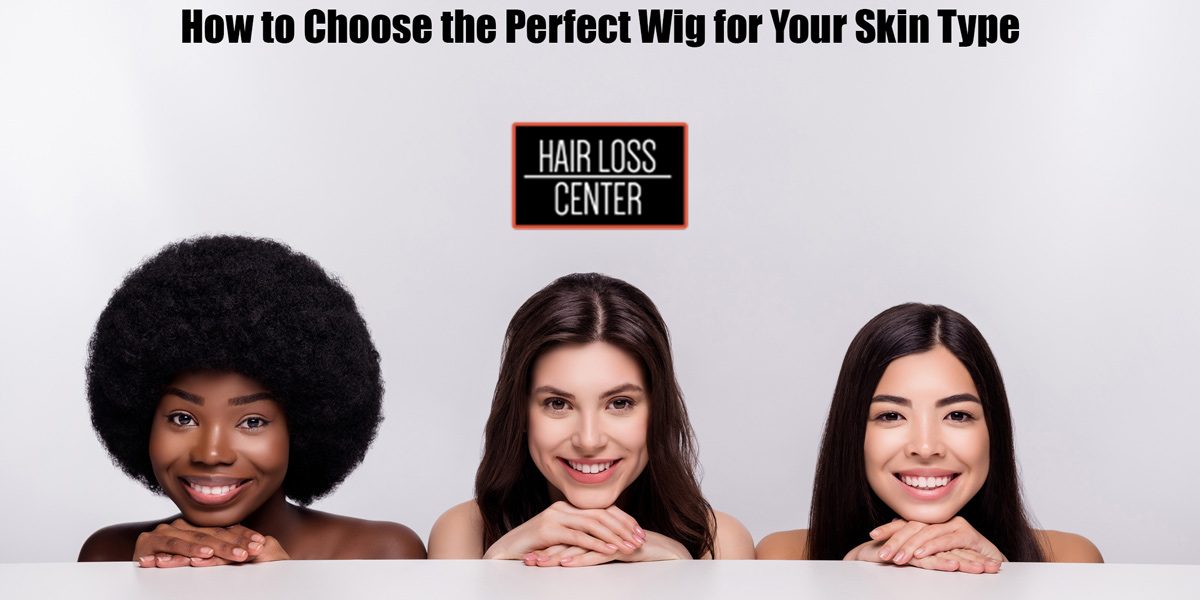Finding the right wig for your skin type is more than just a style choice—it’s a decision that affects your comfort, confidence, and overall appearance. At Hair Loss Center San Diego, we believe that choosing the perfect wig should be an empowering experience, whether you’re dealing with hair loss, a medical condition, or simply want to explore a new look.
With so many wig types, materials, and styles available, understanding how your skin type influences your wig choice is essential. Different skin types—whether dry, oily, sensitive, or combination—react differently to wig materials, cap constructions, and hair textures. Wearing the wrong wig could lead to irritation, discomfort, or even allergic reactions, which is why selecting a wig that complements your skin type is crucial.
Why Your Skin Type Matters When Choosing a Wig
Your skin type determines how a wig will feel on your scalp throughout the day. If you have dry skin, you’ll want a wig that provides hydration and minimizes friction. If your skin is oily, opting for breathable, lightweight materials will help keep your scalp fresh. For those with sensitive or allergy-prone skin, hypoallergenic wigs with gentle, irritation-free materials are the best choice.
- In this guide, we’ll help you:
- Identify your skin type and its specific wig needs.
- Choose the best wig materials for maximum comfort and wearability.
- Explore breathable and hypoallergenic options for sensitive scalps.
- Learn how to pick a wig color that complements your skin tone.
With the right information, you can make an informed decision that ensures both beauty and comfort.
Need expert help choosing a wig for your skin type?
Call 858-284-4832 today for a free consultation with our wig specialists at Hair Loss Center San Diego!
Identifying Your Skin Type to Find the Perfect Wig
Selecting the right wig isn’t just about style—it’s about comfort, durability, and scalp health. Your skin type plays a crucial role in how a wig feels on your scalp and how well it suits your needs. A poorly matched wig can lead to irritation, discomfort, excessive oil buildup, or dryness, which is why understanding your skin type is the first step in making the right choice.
Here’s how to identify your skin type and select a wig that keeps your scalp feeling fresh, comfortable, and irritation-free.
1. Dry Skin: Choosing a Wig That Keeps Your Scalp Hydrated
If your skin often feels tight, flaky, or irritated, you likely have dry skin. A poorly chosen wig can exacerbate dryness, leading to discomfort and itching.
Best Wig Options for Dry Skin:
- Silk or cotton wig caps, which are gentle and help retain moisture.
- Lace front wigs that allow better airflow and reduce dryness.
- Lightweight human hair wigs, which are more breathable and comfortable than synthetic wigs.
- Silk or satin linings to prevent friction and irritation.
What to Avoid:
- Wigs with rough lace or synthetic caps that can cause excessive dryness.
- Tightly fitted wigs that may further restrict airflow.
Pro Tip: Use a silk or satin pillowcase to minimize friction and keep your scalp hydrated while wearing a wig.
2. Oily Skin: Selecting a Wig That Reduces Sweat & Oil Build-Up
If your skin tends to feel greasy or shiny throughout the day and you often experience oil buildup on your scalp and hairline, you have oily skin. Selecting the right wig is essential to prevent discomfort.
Best Wig Options for Oily Skin:
- Lace or mesh wigs made from ultra-breathable materials that allow air circulation.
- Lightweight synthetic wigs that absorb less oil than heavy, dense wigs.
- Wigs with adjustable straps to help prevent excess sweat by allowing a looser fit.
What to Avoid:
- Thick or heavy wigs that trap heat and increase sweating.
- Non-breathable wig caps like full polyurethane, which can feel too warm and uncomfortable.
Pro Tip: Keep both your wig and scalp clean by washing them regularly to remove excess oil and maintain freshness.
3. Sensitive Skin: Hypoallergenic Wigs for Maximum Comfort
If your skin reacts easily to products, fabrics, or environmental changes—causing redness, itching, or burning—you likely have sensitive skin. Choosing a wig that is hypoallergenic and irritation-free is essential.
Best Wig Options for Sensitive Skin:
- Hypoallergenic wigs made from high-quality synthetic fibers or rigorously tested human hair.
- Lace wigs, which provide better airflow and reduce skin irritation.
- Silk-based wig caps that are soft, breathable, and friction-free.
- Human hair wigs, which are more natural and less likely to cause allergic reactions.
What to Avoid:
- Wigs containing harsh chemicals, synthetic dyes, or adhesives, as they can worsen skin sensitivity.
- Tight-fitting caps that can cause friction and irritation.
Pro Tip: Always perform a patch test before wearing a new wig to ensure it doesn’t trigger irritation.
4. Combination Skin: Finding a Balance Between Comfort & Fit

If you experience both dryness and oiliness—usually an oily T-zone and drier cheeks/scalp—you have combination skin. This requires a balanced approach to wig selection.
Best Wig Options for Combination Skin:
- Breathable lace or mesh wigs that allow airflow while preventing excess oil buildup.
- Adjustable wig caps to help achieve a customized fit for both oily and dry areas.
- Lightweight human hair or synthetic wigs that offer a balance of comfort and style.
What to Avoid:
- Heavy, thick wigs that trap heat and aggravate oily areas.
- Overly stiff wig caps that may irritate dry areas of the scalp.
Pro Tip: Use scalp-friendly serums or moisturizers to maintain the perfect balance between hydration and oil control.
Choosing the Right Wig for Scalp Conditions: Psoriasis and Eczema
For individuals with scalp conditions like psoriasis and eczema, wearing a wig can sometimes be uncomfortable due to increased skin sensitivity, inflammation, and irritation. Selecting the right wig that offers breathability, softness, and hypoallergenic properties is crucial to maintaining scalp health while ensuring a natural look and comfortable fit.
This guide will help you understand the best wig materials and styles for psoriasis- and eczema-prone scalps, so you can enjoy a stylish, irritation-free experience.
Psoriasis: How to Choose a Wig That Won’t Aggravate Your Scalp
Psoriasis is a chronic autoimmune condition that causes red, scaly patches on the skin, including the scalp. These patches can become irritated with friction, heat, and certain wig materials, making it essential to choose a wig that reduces discomfort.
Best Wig Options for Psoriasis:
- Hypoallergenic Wigs: Made from gentle materials that minimize irritation and are free from harsh chemicals.
- Lace Front or Full Lace Wigs: Allows air circulation, keeping the scalp cool and reducing itchiness.
- Silk-Based Caps: Provide a soft, smooth interior lining that prevents friction against the scalp.
- Breathable Human Hair Wigs: More natural-feeling and less likely to trap heat than synthetic wigs.
What to Avoid:
- Wigs with tight caps that create friction against psoriasis-prone areas.
- Synthetic wigs with harsh chemicals or dyes that can worsen irritation.
- Full polyurethane caps that trap heat, causing excess sweating and discomfort.
Pro Tip: Keep your scalp moisturized with dermatologist-approved products before wearing your wig to prevent dryness and flare-ups.
Eczema: Selecting a Wig That’s Gentle on Irritated Skin
Eczema, also known as atopic dermatitis, causes inflamed, itchy, and sensitive skin. For individuals experiencing eczema on the scalp, choosing the right wig is critical to avoiding further irritation and promoting comfort.
Best Wig Options for Eczema:
- Silk or Cotton Wig Caps: Soft, natural materials that reduce itching and irritation.
- Lightweight, Breathable Wigs: Lace wigs or those with mesh caps allow for proper air circulation.
- Human Hair Wigs: More breathable and softer than synthetic alternatives.
- Chemical-Free Wigs: Ensure the wig is free of artificial dyes, perfumes, or adhesives that could trigger a reaction.
What to Avoid:
- Wigs made from low-quality synthetic fibers, which may irritate the scalp.
- Wigs with harsh adhesives or glue, as these can cause inflammation.
- Thick, non-breathable caps, which can worsen sweating and itching.
Pro Tip: Before wearing a wig, apply a fragrance-free moisturizer or barrier cream to your scalp to reduce irritation and provide an extra layer of protection.
Additional Tips for Managing Scalp Conditions While Wearing a Wig
- Wash Your Wig Regularly: Prevents product buildup and bacteria that can exacerbate psoriasis or eczema.
- Use Wig Liners: A silk or bamboo wig liner can act as a protective barrier between your scalp and the wig.
- Opt for Adjustable Wig Caps: These allow for a looser fit, reducing pressure and friction on sensitive areas.
- Avoid Wearing a Wig for Extended Periods: Give your scalp breaks to breathe and recover.
Choosing the Best Wigs for Sensitive Skin
If you have sensitive skin, choosing the wrong wig can lead to irritation, discomfort, and even allergic reactions. Many factors, such as wig materials, construction, and fit, play a crucial role in ensuring a comfortable and irritation-free experience. The good news is that hypoallergenic, breathable, and lightweight wigs are available to help you achieve the perfect balance between style and comfort.
In this section, we’ll explore the best wig materials, cap constructions, and hypoallergenic options to help you find the perfect wig for your sensitive skin.
Hypoallergenic Wigs: The Best Choice for Sensitive Skin
For individuals with allergy-prone or easily irritated skin, selecting a hypoallergenic wig is essential. These wigs are made from skin-friendly, non-toxic materials that reduce the risk of irritation and allergic reactions.
Best Hypoallergenic Wig Options:
- Medical-Grade Synthetic Wigs: Designed specifically for sensitive scalps, these wigs are made from high-quality fibers that minimize irritation.
- Human Hair Wigs: Natural and chemical-free human hair wigs are a great choice as they feel soft and breathable.
- Silk or Bamboo Wig Liners: These provide an additional layer of protection between your scalp and the wig, preventing direct irritation.
- Lace Front Wigs: Offer better airflow and a more natural feel, reducing discomfort for sensitive skin.
What to Avoid:
- Wigs made from low-quality synthetic materials that contain harsh chemicals or dyes.
- Wig caps with stiff lace or rough seams, which can cause friction and irritation.
- Glue-on wigs that require adhesives, which may contain allergens or chemicals that can trigger skin reactions.
Pro Tip: Always check if the wig has been dermatologically tested to ensure it’s safe for sensitive skin.
Lace Wigs: A Breathable and Comfortable Option
Lace wigs are a top choice for individuals with sensitive scalps due to their lightweight and breathable design. They help prevent excess sweating, which can lead to irritation and itching.
Why Lace Wigs Are Ideal for Sensitive Skin:
- Superior Breathability: The lace construction allows for better airflow, keeping your scalp cool.
- Soft and Lightweight: Reduces friction and prevents irritation caused by heavy materials.
- Customizable Fit: Adjustable straps and soft linings make them more comfortable for prolonged wear.
What to Look For:
- Full Lace or Lace Front Wigs for maximum comfort.
- Wigs with pre-plucked hairlines to avoid additional pulling and friction.
- Lace that is soft and flexible rather than stiff, which can be irritating.
Best Wigs for Allergy-Prone Skin
If you suffer from allergic reactions to synthetic fibers, adhesives, or wig materials, finding a latex-free, chemical-free, and fragrance-free wig is essential.
Best Wig Options for Allergy-Prone Skin:
- 100% Natural Human Hair Wigs without synthetic coatings or treatments.
- Latex-Free Wigs to prevent allergic reactions.
- Cotton-Based or Silk Wig Caps that provide a soft, skin-friendly barrier.
- Fragrance-Free Wig Products to avoid further scalp sensitivity.
What to Avoid:
- Wigs with rubber or latex bands, which can cause allergic reactions.
- Wigs treated with strong dyes, perfumes, or preservatives.
- Tight-fitting wigs that trap heat and moisture, increasing skin irritation.
Pro Tip: If you have extreme sensitivity, opt for custom-made wigs designed specifically for delicate scalps. This article offers valuable tips on choosing comfortable and stylish wigs for individuals with sensitive skin.
Caring for Your Sensitive Skin While Wearing a Wig
To ensure maximum comfort and avoid irritation, follow these best practices when wearing a wig:
- Choose a Wig with an Adjustable Cap: This prevents excessive pressure on sensitive areas of your scalp.
- Keep Your Scalp Hydrated: Apply a gentle, fragrance-free moisturizer before wearing a wig to prevent dryness and itching.
- Wash Your Wig Regularly: Remove buildup of sweat, oils, and styling products to keep it fresh and skin-friendly.
- Use a Soft Wig Liner: Provides an extra layer of protection and prevents irritation from direct contact with the wig.
- Avoid Wearing a Wig for Extended Periods: Give your scalp a break whenever possible to prevent irritation.
How to Choose a Wig for Your Skin Tone
Choosing the right wig isn’t just about finding a style you love—it’s about selecting a color that complements your skin tone and enhances your natural beauty. The perfect wig color can brighten your complexion, create a more youthful appearance, and boost your confidence. But how do you determine which wig shade will look best on you?
Understanding your undertone is the first step in selecting a wig color that harmonizes with your skin. Whether your skin has cool, warm, or neutral undertones, there’s a wig shade that will enhance your features and give you a natural, radiant look.
In this guide, you’ll learn how to:
- Identify your undertone and how it affects wig color selection.
- Choose the best wig color for cool, warm, or neutral skin tones.
- Match your wig shade to create a balanced and flattering look.
Step 1: Determine Your Skin’s Undertone

Your undertone is the subtle hue beneath your skin’s surface that influences which hair colors suit you best. There are three main undertones:
- Cool Undertones – Skin has hints of blue, pink, or purple. Veins appear blue or purple. Silver jewelry tends to look more flattering.
- Warm Undertones – Skin has hints of gold, yellow, or peach. Veins appear greenish. Gold jewelry looks more flattering than silver.
- Neutral Undertones – A mix of both cool and warm undertones. Veins may appear both blue and green. Can wear both gold and silver jewelry.
Pro Tip: If you’re unsure of your undertone, hold a white sheet of paper next to your face. If your skin looks rosy or bluish, you have cool undertones. If it appears golden or peachy, you have warm undertones.
Step 2: Choosing the Right Wig Color for Your Undertone
Once you’ve determined your undertone, you can select a wig color that enhances your natural features.
Best Wig Colors for Cool Undertones
If you have cool undertones, you’ll look best in hair colors that have ashy, platinum, or cool brown tones.
Ideal Wig Colors:
- Platinum Blonde
- Ash Blonde
- Cool Brown
- Jet Black
- Burgundy or Deep Red
Avoid:
- Warm, golden, or brassy tones, as they may make your skin appear washed out.
Best Wig Colors for Warm Undertones
If your skin has warm undertones, wigs with golden, caramel, and rich brown shades will enhance your natural warmth.
Ideal Wig Colors:
- Golden Blonde
- Caramel or Honey Blonde
- Warm Chocolate Brown
- Auburn or Copper Red
Avoid:
- Ashy or platinum tones, which can make your skin look dull.
Best Wig Colors for Neutral Undertones
If you have a neutral undertone, you have the most flexibility—you can rock both warm and cool tones.
Ideal Wig Colors:
- Neutral Brown
- Soft Black
- Champagne Blonde
- Chestnut Brown
- Subtle Highlights with Mixed Tones
Avoid:
- Extreme shades that are too warm or too cool, as they might overpower your complexion.
Step 3: Matching Your Wig Color to Your Overall Look
When choosing a wig, it’s important to consider more than just your undertone. Your eye color, natural hair color, and personal style also influence what wig shade will look best on you.
- If you have light eyes (blue, green, or hazel), try blondes, caramel browns, or vibrant reds to make them pop.
- If you have dark eyes (brown, black, or deep hazel), opt for rich brunettes, deep reds, or black shades to enhance depth and contrast.
- If you prefer a bold look, try fashion colors like silver, lavender, or pastel hues that contrast beautifully with different undertones.
Pro Tip: If you’re new to wearing wigs and unsure about making a drastic change, start with a shade close to your natural hair color and gradually experiment with highlights or lowlights.
Step 4: Try Before You Buy
- Use Virtual Try-On Tools – Many wig retailers offer online tools where you can upload a photo and test different wig colors.
- Test with Color Swatches – Hold wig swatches next to your face to see how they complement your skin.
- Consult a Wig Expert – A professional can help you choose the most flattering shade for your unique features.
Call 858-284-4832 today for a free consultation and explore our wide selection of wigs designed for all skin types.
FAQs About Choosing the Best Wig for Your Skin Type
Choosing the right wig involves more than just selecting a style—you need to consider your skin type, undertone, scalp sensitivity, and comfort to ensure the best fit. Below are some of the most frequently asked questions about finding a wig that suits your unique needs.
1. What are the best wig materials for sensitive scalps?
The best wigs for sensitive scalps are made from soft, hypoallergenic materials that minimize irritation and provide maximum comfort.
Recommended Materials:
- Silk-Based Wigs – Gentle on the skin and reduce friction.
- Human Hair Wigs – More natural-feeling and breathable than synthetic options.
- High-Quality Synthetic Fibers – Modern, skin-friendly synthetic wigs offer comfort without irritation.
- Lace Front Wigs – Promote airflow and prevent heat buildup.
What to Avoid:
- Low-quality synthetic wigs that contain harsh chemicals.
- Wigs with tight or rough lace that can cause friction and irritation.
2. How do I choose a wig for my skin tone?
To choose a wig that complements your skin tone, first identify whether you have cool, warm, or neutral undertones.
Best Wig Colors by Undertone:
- Cool Undertones: Ash blonde, platinum, cool brown, jet black, deep red.
- Warm Undertones: Golden blonde, honey brown, caramel, copper red.
- Neutral Undertones: Soft black, chestnut brown, champagne blonde, balanced highlights.
Pro Tip: Try a virtual wig color tool or hold wig swatches next to your face to see how different shades enhance your complexion.
3. How can I find the perfect wig for my skin type?
Start by determining whether your skin is dry, oily, sensitive, or combination and then choose a wig material accordingly.
- Dry Skin: Opt for silk-based caps and breathable materials to prevent itching.
- Oily Skin: Look for lace or mesh wigs that allow airflow and reduce sweat buildup.
- Sensitive Skin: Choose hypoallergenic wigs with soft linings.
- Combination Skin: Use adjustable wig caps to achieve a comfortable fit.
4. How do I pick a wig for my complexion?
Your natural hair color, eye color, and undertone should guide your choice.
- Fair Skin Tones: Look great with cool blondes, ash browns, and soft reds.
- Medium Skin Tones: Suit caramel, warm brown, auburn, and rich chocolate shades.
- Deeper Skin Tones: Enhance their look with deep browns, jet black, and rich reds.
5. How do I match the wig color to my skin tone?
To ensure your wig looks natural:
- Identify Your Undertone: Warm, cool, or neutral.
- Choose a Shade Close to Your Natural Hair Color for a subtle transition.
- Try Highlights or Lowlights if you want dimension without a drastic change.
- Test with a Color Swatch before committing to a new shade.
6. How do I choose a natural-looking wig for my skin?
For the most realistic appearance, consider these factors:
- Opt for Lace Front Wigs – These create a natural-looking hairline.
- Select a Hand-Tied or Monofilament Wig – Mimics real hair movement.
- Go for a Gradual Color Transition – Natural hair rarely has a flat color; ombré or highlighted wigs look more realistic.
7. How do I pick a comfortable wig for sensitive skin?
To prevent irritation, follow these comfort-focused tips:
- Look for Adjustable Straps – A snug but not tight fit prevents friction.
- Choose Breathable Materials – Lace or silk-based wigs help with airflow.
- Use a Soft Wig Liner – Provides an extra layer of protection between your scalp and the wig.
8. What are the best wig caps for delicate skin?
The right wig cap can make a huge difference in comfort and wearability.
Best Wig Caps for Sensitive Skin:
- Silk Caps: Reduce friction and feel ultra-soft.
- Cotton Caps: Lightweight and breathable for daily wear.
- Lace Caps: Provide excellent airflow and prevent overheating.
Avoid synthetic wig caps with harsh seams, which can cause irritation.
9. What type of wig is best for people with scalp conditions like psoriasis or eczema?
For individuals with scalp conditions, the right wig can prevent irritation and flare-ups.
Best Wigs for Scalp Conditions:
- Hypoallergenic wigs with gentle, chemical-free fibers.
- Full lace wigs that offer maximum breathability.
- Silk-lined caps to minimize friction on sensitive skin.
What to Avoid:
- Wigs with tight-fitting, synthetic caps that may trap heat and cause discomfort.
- Wigs with adhesives or glue, which can trigger allergic reactions.
10. How often should I wash my wig if I have sensitive skin?
If you have a sensitive scalp, washing your wig regularly helps prevent irritation from sweat, oils, and product buildup.
Washing Recommendations:
- Synthetic wigs: Every 8–10 wears.
- Human hair wigs: Every 7–10 days of use.
- Use a mild, sulfate-free shampoo to avoid harsh chemicals.
Embrace Your True Self with the Perfect Wig
Choosing a wig is more than just finding a hairpiece—it’s about embracing confidence, self-expression, and personal comfort. Whether you’re experiencing hair loss due to a medical condition, looking for a fresh new style, or simply want to enhance your natural beauty, the right wig can empower you to feel your best every day.
At Hair Loss Center San Diego, we believe that a wig should not only look stunning but also provide a comfortable, irritation-free experience. By understanding your skin type, undertones, and scalp sensitivity, you can select a wig that complements your features, lifestyle, and unique personality.
Why Finding the Right Wig Matters
A well-chosen wig can:
- Boost self-confidence by giving you a look that makes you feel empowered.
- Enhance comfort by reducing irritation and scalp sensitivity.
- Improve your overall appearance by matching your skin tone and personal style.
- Provide a natural look with the right wig material and color.
Whether you need a hypoallergenic wig for sensitive skin, a lace front wig for breathability, or a specific shade to match your undertone, there are options available to ensure you feel and look amazing.
Steps to Finding Your Perfect Wig
To embrace your true self with a wig, consider these important steps:
1. Identify Your Skin Type and Scalp Sensitivity
Choosing the right wig starts with understanding your skin type:
- Dry Skin: Look for moisture-retaining, soft materials like silk-based caps.
- Oily Skin: Opt for lace or mesh wigs that allow airflow and prevent excess moisture buildup.
- Sensitive Skin: Select hypoallergenic wigs made from high-quality, irritation-free fibers.
2. Choose a Wig Color That Complements Your Skin Tone
Your skin undertone plays a key role in how natural and flattering a wig looks on you:
- Cool Undertones: Best suited for platinum blonde, ash brown, jet black, or deep red shades.
- Warm Undertones: Golden blonde, caramel, honey brown, and copper red enhance warmth.
- Neutral Undertones: Have the most flexibility—chestnut brown, champagne blonde, and soft black work well.
Trying color swatches or virtual wig try-on tools can help you visualize your perfect shade before purchasing.
3. Select a Wig Style That Matches Your Personality
Your wig should reflect your unique personality, lifestyle, and comfort level. Consider:
- Classic Styles: Straight, natural waves, or soft curls for an elegant, everyday look.
- Bold & Trendy Looks: Layers, ombré colors, or fashion-forward cuts for a more daring style.
- Versatile Options: Lace front wigs, adjustable caps, or wigs with parting flexibility to switch up your look easily.
4. Prioritize Comfort and Fit
A well-fitted wig makes all the difference in long-term wearability and confidence. Look for:
- Lightweight wigs that prevent overheating.
- Adjustable straps for a snug but comfortable fit.
- Soft lace or silk-lined caps to minimize friction against sensitive scalps.
Using a wig liner or scalp protector can also help create a barrier for extra comfort.
Your Journey to Confidence Starts Here
Finding the perfect wig is more than just about looks—it’s a journey toward embracing your authentic self with confidence. When you choose a wig that suits your skin type, scalp needs, and personal style, you’ll feel more comfortable and radiant in your daily life.
At Hair Loss Center San Diego, we specialize in helping clients find high-quality, comfortable, and stylish wigs tailored to their needs. Whether you’re searching for medical-grade wigs, breathable lace wigs, or the perfect shade to complement your skin, we’re here to help you every step of the way.
Call us at 858-284-4832 today for a free consultation and take the first step toward embracing your true self with the perfect wig.


